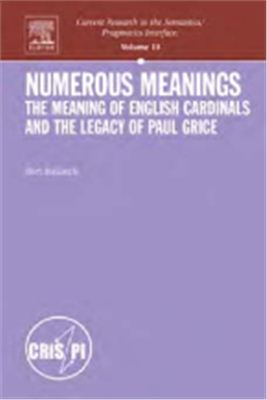Contents.
acknowledgements.
Conventions.
ntroduction.
The Gricean theory of implicatures.
ntroduction.
mplicatures according to Paul Grice.
Meaning.
Logic and conversation.
Formalists and informalists.
Maxims and implicatures.
Rescuing logic in conversation (1): therefore.
Rescuing logic in conversation (2): or.
Rescuing logic in conversation (3): if. then.
Conclusion.
mplicatures according to neo-Griceans and critics.
ersions of the conversational principles and their indeterminacy.
Tests of conversational implicatures.
Formalizations.
Scales.
The projection problem.
The architecture of meaning.
Consequences for the analysis of meaning.
Three decades of Gricean numerals.
Minimalism and implicatures: tradition and evolution.
Ho's original analysis.
Existentialist minimalism.
Salience and activation.
Underspecification.
Early approaches and formulations.
Underspecification, underdeterminacy and enrichment.
Marginal positions: punctual semantics and ambiguity.
Summary and 'absolute value'.
General corpus analysis of the forms and functions of English cardinals.
Prolegomenon: The English lexical category "numeral".
Semantics.
Open - closed class.
Syntax.
Conclusion.
Forms of two.
Adnominal and pronominal uses of two.
Analysis of the Np containing two.
Restrictors.
Complex constructions.
Functions of two: corpus analysis.
Cardinal two.
Two as a label.
Standard examples.
Marginal labels: Counting the seconds one two three.
Number two.
Clockwise: two in indications of temporal location.
Pronominal two and ellipsis.
Standard examples.
Elliptical two as the predicate of a copula.
Divide into two.
A a. Degrees of pronominality: what about you two?
Two as the name of a symbol.
Mathematical uses of two.
Discourse-structural two.
Other uses of two.
Relationship between adnominal form and cardinal function.
Degrees of prominence of cardinality.
Domains of use.
A special case: Zero.
Zero as adnominal.
Zero as head.
Comparison of two and zero.
Conclusion.
'At least n\ 'exactly n', 'at most n' and 'absolute value' readings.
Methodology.
Absolute values and 'exactly n1 values of two in N CN and pronominal uses.
ncreasing the number of positions - the concept 'absolute value'.
'Absolute value' and 'exactly n' readings of two in the corpus: a continuum.
Syntactic function of the Np containing two.
Two in adverbial phrases.
Two in direct object phrases.
Two in subject phrases and gradations of 'absolute value'.
Two in predicate phrases and the "existential there"-effect.
Hierarchy of syntactic functions.
Comparison with Discourse Topic Theory: Van Kuppevelt (1996) and.
Scharten (1997).
Other determinants of value interpretation.
Relative strength of factors influencing value interpretation.
nfluence of pronominality and reduced cardinality.
Summary.
'At least / more than n' and 'at most / less than n1 uses of two in the corpus.
and the influence of modalism.
Neo-Gricean arguments in the corpus analysis of two.
Defeasibility: the cancellation and suspension tests.
The suspension test.
The cancellation test.
Redundancy.
Negation.
Conclusion.
Small numbers, large numbers, round numbers and non-round numbers.
Ten 111.
Twenty-two.
One thousand.
Restrictors.
Survey of restrictors: from 'more than' to 'less than'.
"Epistemic load".
Approximativity and exactness.
Only and just.
Conclusion.
References.
Index.
acknowledgements.
Conventions.
ntroduction.
The Gricean theory of implicatures.
ntroduction.
mplicatures according to Paul Grice.
Meaning.
Logic and conversation.
Formalists and informalists.
Maxims and implicatures.
Rescuing logic in conversation (1): therefore.
Rescuing logic in conversation (2): or.
Rescuing logic in conversation (3): if. then.
Conclusion.
mplicatures according to neo-Griceans and critics.
ersions of the conversational principles and their indeterminacy.
Tests of conversational implicatures.
Formalizations.
Scales.
The projection problem.
The architecture of meaning.
Consequences for the analysis of meaning.
Three decades of Gricean numerals.
Minimalism and implicatures: tradition and evolution.
Ho's original analysis.
Existentialist minimalism.
Salience and activation.
Underspecification.
Early approaches and formulations.
Underspecification, underdeterminacy and enrichment.
Marginal positions: punctual semantics and ambiguity.
Summary and 'absolute value'.
General corpus analysis of the forms and functions of English cardinals.
Prolegomenon: The English lexical category "numeral".
Semantics.
Open - closed class.
Syntax.
Conclusion.
Forms of two.
Adnominal and pronominal uses of two.
Analysis of the Np containing two.
Restrictors.
Complex constructions.
Functions of two: corpus analysis.
Cardinal two.
Two as a label.
Standard examples.
Marginal labels: Counting the seconds one two three.
Number two.
Clockwise: two in indications of temporal location.
Pronominal two and ellipsis.
Standard examples.
Elliptical two as the predicate of a copula.
Divide into two.
A a. Degrees of pronominality: what about you two?
Two as the name of a symbol.
Mathematical uses of two.
Discourse-structural two.
Other uses of two.
Relationship between adnominal form and cardinal function.
Degrees of prominence of cardinality.
Domains of use.
A special case: Zero.
Zero as adnominal.
Zero as head.
Comparison of two and zero.
Conclusion.
'At least n\ 'exactly n', 'at most n' and 'absolute value' readings.
Methodology.
Absolute values and 'exactly n1 values of two in N CN and pronominal uses.
ncreasing the number of positions - the concept 'absolute value'.
'Absolute value' and 'exactly n' readings of two in the corpus: a continuum.
Syntactic function of the Np containing two.
Two in adverbial phrases.
Two in direct object phrases.
Two in subject phrases and gradations of 'absolute value'.
Two in predicate phrases and the "existential there"-effect.
Hierarchy of syntactic functions.
Comparison with Discourse Topic Theory: Van Kuppevelt (1996) and.
Scharten (1997).
Other determinants of value interpretation.
Relative strength of factors influencing value interpretation.
nfluence of pronominality and reduced cardinality.
Summary.
'At least / more than n' and 'at most / less than n1 uses of two in the corpus.
and the influence of modalism.
Neo-Gricean arguments in the corpus analysis of two.
Defeasibility: the cancellation and suspension tests.
The suspension test.
The cancellation test.
Redundancy.
Negation.
Conclusion.
Small numbers, large numbers, round numbers and non-round numbers.
Ten 111.
Twenty-two.
One thousand.
Restrictors.
Survey of restrictors: from 'more than' to 'less than'.
"Epistemic load".
Approximativity and exactness.
Only and just.
Conclusion.
References.
Index.

